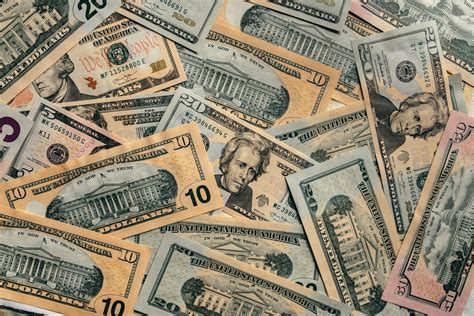The United States money, also known as the US dollar, is the official currency of the United States and one of the most widely traded and recognized currencies in the world. The history of US money is a long and complex one, with various forms of currency being used throughout the country’s history.
Early Forms of Currency
In the early days of the United States, various forms of currency were used, including foreign coins, colonial scrip, and commodity-based currencies such as tobacco and wampum. The first national currency, the Continental-dollar, was introduced during the American Revolution, but it suffered from significant inflation and was eventually replaced by the US dollar.
The Gold Standard
In 1879, the United States adopted the gold standard, which pegged the value of the US dollar to the value of gold. Under this system, people could exchange their dollars for a corresponding amount of gold. The gold standard helped to stabilize the value of the dollar and facilitated international trade. However, it also limited the government’s ability to implement monetary policy and respond to economic downturns.
The Federal Reserve System
In 1913, the Federal Reserve System was established, which gave the government more control over the money supply and allowed for the implementation of monetary policy. The Federal Reserve, also known as the “Fed,” is responsible for setting interest rates, regulating banks, and maintaining the stability of the financial system.
The Great Depression and World War II
During the Great Depression, the US money system was put to the test. The stock market crash of 1929 led to a sharp decline in economic activity, and the subsequent banking crisis led to a significant reduction in the money supply. In response, the government implemented a series of policies, including the establishment of the Federal Deposit Insurance Corporation (FDIC) and the implementation of expansionary monetary policy.
During World War II, the US money system played a critical role in financing the war effort. The government issued war bonds and increased the money supply to finance military spending. The war also led to a significant increase in international trade, which helped to establish the US dollar as a global reserve currency.
The Fiat Currency System
In 1971, the United States abandoned the gold standard and adopted a fiat currency system, in which the value of the dollar is determined by supply and demand in the foreign exchange market. Under this system, the government has more flexibility to implement monetary policy and respond to economic downturns. However, it also increases the risk of inflation and currency devaluation.
Modern US Money System
Today, the US money system is a complex and sophisticated system that involves multiple players and institutions. The Federal Reserve plays a central role in setting monetary policy and regulating the financial system. The government also plays a critical role in implementing fiscal policy and regulating the financial sector.
The US dollar is widely used as a global reserve currency, and it is the most widely traded currency in the world. The dollar is also used as a store of value, a unit of account, and a medium of exchange. The stability and credibility of the US money system are critical to maintaining international trade and finance.
Key Players and Institutions
There are several key players and institutions that play a critical role in the US money system. These include:
- The Federal Reserve: The central bank of the United States, responsible for setting monetary policy and regulating the financial system.
- The US Treasury: Responsible for managing the government’s finances, including borrowing and debt management.
- Commercial banks: Provide banking services to individuals and businesses, and play a critical role in the transmission of monetary policy.
- Investment banks: Provide investment banking services, including underwriting and trading securities.
- Shadow banks: Non-traditional financial institutions that provide banking services, including hedge funds and private equity firms.
Challenges and Risks
The US money system faces several challenges and risks, including:
- Inflation: A sustained increase in the general price level of goods and services, which can erode the purchasing power of the dollar.
- Deflation: A sustained decrease in the general price level of goods and services, which can lead to reduced spending and economic activity.
- Currency devaluation: A decrease in the value of the dollar relative to other currencies, which can make imports more expensive and reduce international trade.
- Financial instability: A sudden and significant disruption to the financial system, which can lead to a loss of confidence and a decline in economic activity.
Solutions and Reforms
To address these challenges and risks, several solutions and reforms have been proposed, including:
- Monetary policy reform: Changes to the way monetary policy is implemented, including the use of alternative monetary policy tools and the adoption of inflation targeting.
- Financial regulation: Strengthening financial regulation to prevent excessive risk-taking and promote financial stability.
- Fiscal policy reform: Changes to the way fiscal policy is implemented, including the adoption of fiscal rules and the implementation of tax reform.
- International cooperation: Increased cooperation and coordination among countries to address global economic challenges and promote international financial stability.
Conclusion
In conclusion, the US money system is a complex and sophisticated system that plays a critical role in the US economy and international finance. Understanding the history, structure, and challenges of the US money system is essential for developing effective policies and reforms to promote economic stability and growth.
FAQs
What is the official currency of the United States?
+The official currency of the United States is the US dollar.
What is the role of the Federal Reserve in the US money system?
+The Federal Reserve plays a central role in setting monetary policy and regulating the financial system.
What are some of the challenges and risks facing the US money system?
+The US money system faces several challenges and risks, including inflation, deflation, currency devaluation, and financial instability.
What are some potential solutions and reforms to address these challenges and risks?
+Several solutions and reforms have been proposed, including monetary policy reform, financial regulation, fiscal policy reform, and international cooperation.
Why is the US dollar widely used as a global reserve currency?
+The US dollar is widely used as a global reserve currency due to its stability, credibility, and widespread use in international trade and finance.



